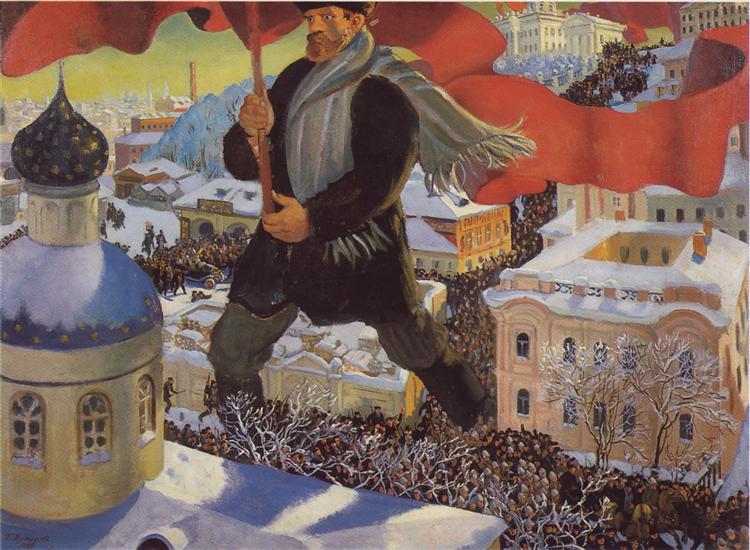Kustodiev Boris – “Bolshevik”
Three years after the February Revolution and the creation of the painting “February 27, 1917”, Boris Kustodiev, already bedridden and in a wheelchair, paints the painting “Bolshevik”, in which he turned not to direct impressions, as in February 1917, but to synthesis , comprehension of the main thing that was associated with the concept of “Bolshevik”. This is the October Revolution, and the famine in Petrograd since the fall of 1918, and the Civil War, which has not yet ended, but in which Kolchak, Denikin, Yudenich have already been beaten and there has been a clear turning point in favor of the “Reds”. Kustodiev played with the very word “Bolshevik”, which the people often tried to naively explain as something “big”, strong. The picture is frankly built on the basis of popular prints. In the bright sunshine of the end of winter, like on Shrovetide, a mighty giant walks through the city, a giant in soldiers’ boots and a city scarf, with furiously frowning eyebrows and a red banner in his hands. It winds over houses with an endless scarlet ribbon, and wherever it appears, the streets are filled with continuous streams of armed people who have come into motion – soldiers and sailors, someone sneaks along the wall with a rifle, somewhere there is a meeting with an orator, speaking in front of the soldiers from the car. The picture is characterized by the atmosphere of fantastic reality, a kind of “cheap print surrealism”. The expression is enhanced by a sharp combination of different angles – from below to the giant that monumentalizes him, from above to the crowd at his feet. The composition strangely echoes the image of a skeleton in the city in 1905, but here an obstacle rises in front of the walking figure – a church with a blue dome decorated with gold stars, and it remains unclear whether the giant will bypass it or sweep it out of its way. It is impossible to stop it.
In this image of symbolism and allegorical character, Kustodiev revealed the spontaneous force of the revolution, the massiveness of everything connected with it, expressed a mixed feeling of both involuntary admiration for power and fear of brute force. The sunny city landscape is conveyed differently, especially it was given away – with admiration for its peaceful poetic beauty.
Year of painting: 1920.
Dimensions of the painting: 101 x 141 cm.
Material: canvas.
Writing technique: oil.
Genre: allegory.
Style: modern.
Gallery: State Tretyakov Gallery, Moscow, Russia.
